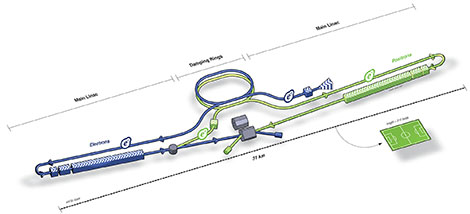- Cavity temperature:
2 K (-271.2 °C or -456 °F)
- Detectors:
2, based on complementary technologies
- Site:
To be determined in the next phase of the project
- ILC Community:
Nearly 300 laboratories and universities around the world are involved in the ILC: more than 700 people are working on the accelerator design, and another 900 people on detector development. The accelerator design work is coordinated by the Global Design Effort, and the physics and detector work by the World Wide Study.
|
- Collisions:
Between electrons and their antiparticles, positrons, in bunches of 5 nanometres (5 billionths of a metre) in height each containing 20 billion particles and colliding 14,000 times per second
- Energy:
Up to 500 billion electronvolts (GeV) with an option to upgrade to 1 trillion electronvolts (TeV)
- Acceleration Technology:
16,000 superconducting accelerating cavities made of pure niobium
- Length:
Approximately 31 kilometres, plus two damping rings each with a circumference of 6.7 kilometres
- Accelerating Gradient:
31.5 megavolts per metre
|

